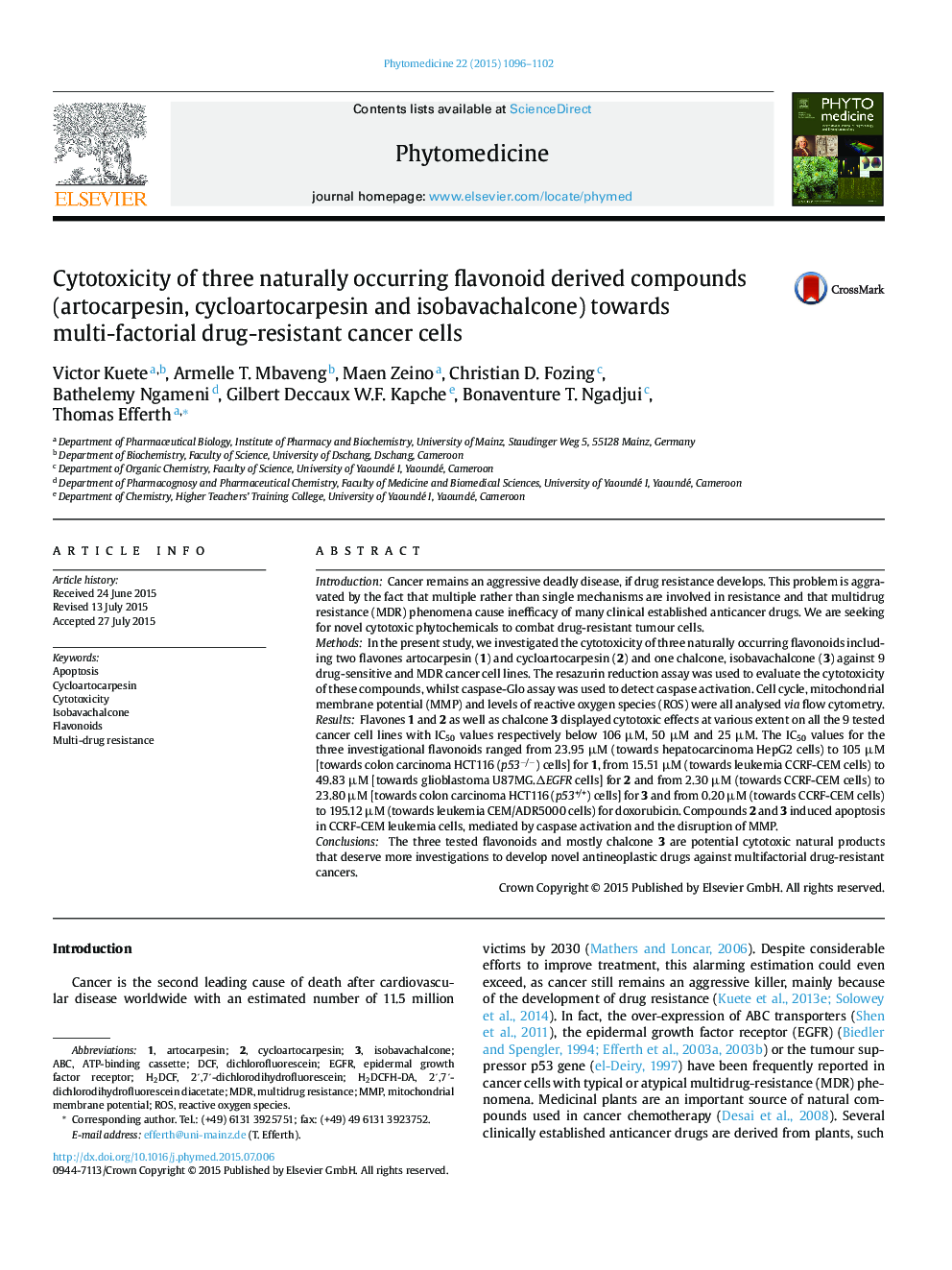| کد مقاله | کد نشریه | سال انتشار | مقاله انگلیسی | نسخه تمام متن |
|---|---|---|---|---|
| 2496342 | 1116127 | 2015 | 7 صفحه PDF | دانلود رایگان |
IntroductionCancer remains an aggressive deadly disease, if drug resistance develops. This problem is aggravated by the fact that multiple rather than single mechanisms are involved in resistance and that multidrug resistance (MDR) phenomena cause inefficacy of many clinical established anticancer drugs. We are seeking for novel cytotoxic phytochemicals to combat drug-resistant tumour cells.MethodsIn the present study, we investigated the cytotoxicity of three naturally occurring flavonoids including two flavones artocarpesin (1) and cycloartocarpesin (2) and one chalcone, isobavachalcone (3) against 9 drug-sensitive and MDR cancer cell lines. The resazurin reduction assay was used to evaluate the cytotoxicity of these compounds, whilst caspase-Glo assay was used to detect caspase activation. Cell cycle, mitochondrial membrane potential (MMP) and levels of reactive oxygen species (ROS) were all analysed via flow cytometry.ResultsFlavones 1 and 2 as well as chalcone 3 displayed cytotoxic effects at various extent on all the 9 tested cancer cell lines with IC50 values respectively below 106 µM, 50 µM and 25 µM. The IC50 values for the three investigational flavonoids ranged from 23.95 µM (towards hepatocarcinoma HepG2 cells) to 105 µM [towards colon carcinoma HCT116 (p53−/−) cells] for 1, from 15.51 µM (towards leukemia CCRF-CEM cells) to 49.83 µM [towards glioblastoma U87MG.ΔEGFR cells] for 2 and from 2.30 µM (towards CCRF-CEM cells) to 23.80 µM [towards colon carcinoma HCT116 (p53+/+) cells] for 3 and from 0.20 µM (towards CCRF-CEM cells) to 195.12 µM (towards leukemia CEM/ADR5000 cells) for doxorubicin. Compounds 2 and 3 induced apoptosis in CCRF-CEM leukemia cells, mediated by caspase activation and the disruption of MMP.ConclusionsThe three tested flavonoids and mostly chalcone 3 are potential cytotoxic natural products that deserve more investigations to develop novel antineoplastic drugs against multifactorial drug-resistant cancers.
Artocarpesin (1), cycloartocarpesin (2) and isobavachalcone (3) displayed cytotoxic effects on all the 9 tested cancer cell lines with IC50 values respectively below 106 µM, 50 µM and 25 µM. The IC50 values ranged from 23.95 µM (towards hepatocarcinoma HepG2 cells) to 105 µM [towards colon carcinoma HCT116 (p53−/−) cells] for 1, from 15.51 µM (towards leukemia CCRF-CEM cells) to 49.83 µM [towards glioblastoma U87MG.ΔEGFR cells] for 2 and from 2.30 µM (towards CCRF-CEM cells) to 23.80 µM [towards colon carcinoma HCT116 (p53+/+) cells] for 3. Compounds 2 and 3 induced apoptosis in CCRF-CEM leukemia cells, mediated by caspase activation and the disruption of MMP.Figure optionsDownload high-quality image (67 K)Download as PowerPoint slide
Journal: Phytomedicine - Volume 22, Issue 12, 15 November 2015, Pages 1096–1102
